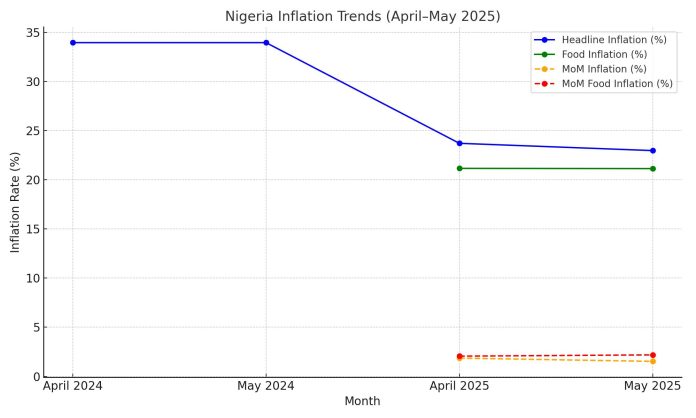Nigeria’s headline inflation rate dropped to 22.97% in May 2025, marking a significant slowdown in the pace of price increases across the country, according to new figures released by the National Bureau of Statistics (NBS).
The May inflation rate reflects a 0.74 percentage point drop from April’s 23.71%, offering cautious optimism for consumers and policymakers alike.
On a month-on-month basis, inflation eased to 1.53% in May from 1.86% in April, suggesting a deceleration in the rise of prices for goods and services. This marks one of the sharpest month-on-month slowdowns in recent months.
Year-on-year, the data presents even more striking progress. The current inflation rate is 10.98 percentage points lower than the 33.95% recorded in May 2024—a reflection of both improved policy impact and statistical base effects.
The NBS attributed the decline primarily to a slowdown in the rate of price increases across several key segments of the economy, including farm produce, utilities, clothing, and healthcare services.
In the food segment, food inflation dipped slightly to 21.14% in May, down from 21.16% in April on a year-on-year basis. The agency noted that while prices of essential food items still rose in May, the pace was relatively slower due to base-year effects from the inflation rebasing process.
However, on a month-on-month basis, food inflation increased marginally to 2.19% in May, compared to 2.06% in April, signaling persistent pressures in the food supply chain.
Analysts say the overall figures reflect progress in government efforts to stabilize the macroeconomic environment, especially through recent fiscal and monetary coordination. However, they warn that marginal increases in monthly food prices remain a concern, particularly for low-income households.
With the next Monetary Policy Committee (MPC) meeting approaching, the inflation figures are expected to play a key role in shaping future interest rate decisions by the Central Bank of Nigeria.
The moderation in inflation offers some relief to consumers but underscores the importance of sustained structural reforms in agriculture, power supply, logistics, and manufacturing to maintain the downward trend.














